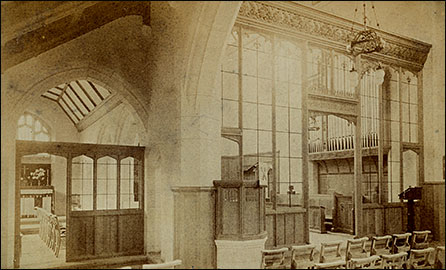|
|||
| Extracted from 'A Century of Witness 1895-1995' | |||
|
Origins
(To becoming a Parish in 1913) |
|||
|
|||
|
The establishment of St Peter’s Church was closely linked with the expansion of Rushden in the last decades of the 19th century, from being a village, centred around St Mary’s Church and the High Street, with a population of around 2,000, Rushden had expanded to over 7,000 by the time of the 1891 census. There were now buildings to the north as well as the south of the town and further expansion seemed likely. This growth was mainly because of the development of the boot and shoe industry and the coming of the Wellingborough to Higham Ferrers railway line. Pastoral concern for the new people in the town led first of all to the building of a Mission Hall (also used as an Infant School) in A New “ By the Mid-1890s it was clear that these premises were inadequate as the town was still expanding and many new houses were being built and new streets established – Midland Road, Pemberton Street, Oakley Road, Windmill Road, to name but a few. Therefore at the end of 1893 a proposal was put before the St. Mary’s Church Council for the building of a Mission Room or Events then moved rapidly; In January 1894, one hundred people met in Moor Road Schoolroom and showed keen interest in the proposals made by the Church Council. A committee of eight people was set up to promote the scheme for the new church. By March there was a larger committee in three divisions to organise the collection of funds in different parts of the parish. Further meetings led to a resolution at the July Council meeting that plans for a building be obtained and Mr F.E.Preston was commissioned to prepare the design. On the 1st August 1894 seven tenders were received from Rushden builders and Mr R.Marriott’s quote of £770 was accepted. The contract was signed on the 15th August and work began. Money continued to be raised by subscriptions and other activities were planned including a Bazaar for July 1895. Meanwhile money was advanced by the Union Bank and guaranteed by Trustees, the Rector and Churchwardens. In November 1894 the parish magazine reported: “The building of the new Special gifts were invited for furnishing the chancel. The altar table was one used in St. Mary’s until 20 years previously, the font was provided from subscriptions by the Sunday School Children and there were other private gifts for a moveable pulpit, a lectern, a Bible, harmonium, alms dish and other ornaments. Dedication On Thursday 24th January 1895 at 3.00pm, the new On Friday 25th January, there was an evening service at St. Peter’s at 7.30pm. On the Sunday following Holy Communion was celebrated for the first time and three other services that day were very well attended. The font was used for the baptism of 17 children. The Rector at the time in succession to Canon Barker, was the Reverend C.J.Gordon, and the curate, the Reverend C.Blathwayte, who was mainly responsible for the work at St. Peter’s. Several other curates also helped at the “new The July 1895 Bazaar raised £331.2s. towards the expense of the Church, to add to about £250 given or promised. The cost of the land had already been met.
Towards a New Church and Parish
The The work and congregation of St. Peter’s was soon well established and before long it became clear that the existing building was too small, especially as Rushden was still growing in size. Fortunately, the possibility that a larger church might be needed had been foreseen when the land was purchased and when Archdeacon Kitchin became Rector of Rushden in 1905, plans were made for a larger building, toward which £2,000 had already been collected. The Reverend C.J.Gordon (who had left Rushden in 1895) donated a further £1,000 towards the total cost of £4,800. As for the original building, plans were drawn up by Messrs Talbot, Brown and Fisher, and Robert Marriott was awarded the contract from the ten tenders received. The foundation stone was laid by Lord Ampthill on 25th September 1906 and the church was consecrated by the Right Reverend the Honourable Edward Carr Glyn, Bishop of 1st Organist Mr.W.P.Jolley (appointed Oct.1907) 1st Baptism Lilian Maud Coles (Dec.15th 1907) 1st Marriage Walter Garley to Gertrude Ellen King (Christmas Day 1907) A Separate Parish By 1912 it was hoped to clear the debt on the Church and apply for legal separation to become an independent parish. Before this was completed the advowson (patronage) of Rushden was transferred to the Church Pastoral Aid Society by Canon Barker’s son who had inherited it on the death of his father. The Rector, Mr Kitchin, negotiated a special concession for St. Peter’s… that for 20 years, the Bishop of Peterborough would retain the advowson. In April 1913 the final (by this time very small) debt on St. Peter’s was cleared by four donors including no lesser person than King George V. In July 1913 a new Curate-in‑charge, the Reverend P.J.Richards was appointed and became the first vicar when St. Peter’s was established as a separate parish (by Order in Council Oct.1913). The new Vicar was instituted on December 4th 1913.
|
|||
